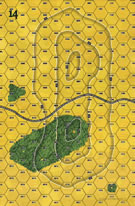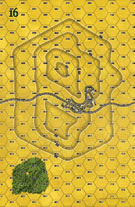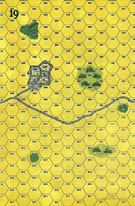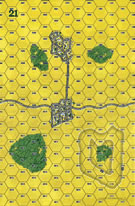|
|
|
Total |
| Side 1 |
1 |
| Draw |
0 |
| Side 2 |
0 |
|
Total |
| Side 1 |
1 |
| Draw |
0 |
| Side 2 |
0 |
|
Total |
| Side 1 |
0 |
| Draw |
0 |
| Side 2 |
0 |
|
| Overall Rating, 1 vote |
|---|
|
|
|
Scenario Rank:
--- of 940 |
| Parent Game |
Edelweiss IV |
| Historicity |
Historical |
| Date |
1941-05-25 |
| Start Time |
06:30 |
| Turn Count |
28 |
| Visibility |
Day |
| Counters |
116 |
| Net Morale |
0 |
| Net Initiative |
3 |
| Maps |
4: 14, 16, 19, 21 |
| Layout Dimensions |
86 x 56 cm
34 x 22 in |
| Play Bounty |
198 |
| AAR Bounty |
227 |
| Total Plays |
1 |
| Total AARs |
0 |
|
Introduction
|
|
After German paratroopers secured airfields, troops of the 5th Mountain Division began to land on Crete from Ju52 transport planes. They soon joined the paratroopers in a concentric attack on the key crossroads town of Galatas. While a parachute group led by Col. Bernhard Ramcke of 1st Parachute Regiment advanced eastward along the coast, the 100th Mountain Regiment on their right would tackle the position know as Wheat Hill.
|
|
Conclusion
|
|
Col. Howard Kippenberger, commander of the ad hoc 10 Brigade, strode through his front-line positions shouting "Stand for New Zealand!" His troops failed to heed his exhortations, and troops from 18 Battalion abandoned Wheat Hill against his orders, while the Composite Battalion - cooks, drivers, petrol handlers and the like armed and shoved into the line - simply melted away. The failure would not stain Kip's career, he would later command 2nd New Zealand Division in Italy and edit the Army's official history of the Second World War (and decline the opportunity to erase this failure from the record).
|
Display Relevant AFV Rules
| AFV Rules Pertaining to this Scenario's Order of Battle |
- Vulnerable to results on the Assault Combat Chart (7.25, 7.63, ACC), and may be attacked by Anti-Tank fire (11.2, DFT). Anti-Tank fire only affects the individual unit fired upon (7.62, 11.0).
- AFV's are activated by tank leaders (3.2, 3.3, 5.42, 6.8).
They may also be activated as part of an initial activating stack, but if activated in this way would need a tank
leader in order to carry out combat movement.
- AFV's do not block Direct Fire (10.1).
- Full-strength AFV's with "armor efficiency" may make two anti-tank (AT) fire attacks per turn
(either in their action segment or during opportunity fire) if they have AT fire values of 0 or more
(11.2).
- Each unit with an AT fire value of 2 or more may fire at targets at a distance of between 100% and 150% of its
printed AT range. It does so at half its AT fire value. (11.3)
- Efficient and non-efficient AFV's may conduct two opportunity fires per turn if using direct fire
(7.44, 7.64).
Units with both Direct and AT Fire values may use either type of fire in the same turn as their opportunity fire,
but not both (7.22, 13.0).
Units which can take opportunity fire twice per turn do not have to target the same unit both times (13.0).
- Demoralized AFV's are not required to flee from units that do not have AT fire values (14.3).
- Place a Wreck marker when an AFV is eliminated in a bridge or town hex (16.3).
- AFV's do not benefit from Entrenchments (16.42).
- AFV's may Dig In (16.2).
- Open-top AFV's: Immune to M, M1 and M2 results on Direct and Bombardment Fire Tables, but DO take step losses from X and #X results (7.25, 7.41, 7.61, BT, DFT). If a "2X" or "3X" result is rolled, at least one of the step losses must be taken by an open-top AFV if present.
- APC – Armored Personnel Carrier: These are Combat Units, but stack like Transports. They can transport personnel units or towed units. They are not counted as combat units for the +1 stacking modifier on the Direct Fire and Bombardment Tables (4.4). They may be activated by regular leaders and tank leaders (1.2, 3.34, 4.3, 5.43). They do not provide the +1 Assault bonus (ACC).
|
New Zealand Order of Battle
| 2 Errata Items |

|
Two British infantry have their full strengths printed on the back. They should both be "2-3" when reduced.
|

|
Reduce strength direct fire value be came 5-5 in Army at Dawn.
|








 EdIV007
EdIV007 































